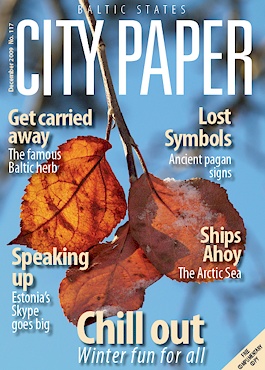Light On For Latvia!
 Nov. 18, 2008 marks the nation's 90th year of independence. Lights on for Latvia! is the motto of the Jubilee celebrations, which began 90 days before the birthday and will continue into early next year.
These are hard times.
Nov. 18, 2008 marks the nation's 90th year of independence. Lights on for Latvia! is the motto of the Jubilee celebrations, which began 90 days before the birthday and will continue into early next year.
These are hard times.
"We've heard it, we know it and we feel it. But life must go on – there've been hard times before. Sometimes, we could all do with a little ray of light to find our way out of the darkness. And here it is: Latvia's lights have been turned on, as this year does give us something to celebrate. Something that ended the darkness of bygone times. Nov. 18, 1918, Latvia's Independence Day, was an event that changed the course of history.
For the first time, the Latvian people were given autonomy and freedom and the opportunity to shape their own nation. Ninety years on, the Latvian people are throwing a massive party in remembrance of this day. The 2 million lat project has been in the making since Jan. 2008. The first of the 500 plus celebrations kicked off in May this year. "There are more than 500 events planned over 90 days, in Latvia and in all countries where Latvian people are living," said a representative from the Ministry of Defense, the body organizing the festivities.
The soiree stretches out as far as America, Canada, Germany and the U.K. and even has a coin in its name. The Bank of Latvia released the silver Jubilee coin last month, dedicated to the nation, "honoring its beginnings and expressing confidence in its future." The Jubilee celebrations do not just end with the fireworks on Nov. 18. Visit www.lv90.lv to find out what's going on throughout this month and next. Histstory On Nov. 18, 1918, at 4.30 p.m. at Riga's 'Second Theatre' (now called the National Theatre), the Republic of Latvia was proclaimed.
However, the fight for independence was a long and strenuous one after an already unsavory history of war and occupation. According to historian Juris Ciganovs, assistant director of Latvia's Museum of War, Latvians' national consciousness and level of political activity were raised by the combined effects of the ravages of World War I and Soviet occupation. After Russia's February revolution of 1917, many Latvians started to clamor for independence and the first genuinely Latvian political parties were formed. More and more often the national symbols - the white and maroon flag and the song "Dievs Sveti Latviju" (God Bless Latvia) - were seen and heard in ever wider sections of the population.
Lights on For Latvia! marks the nation's 90th year of independence. Lights on for Latvia! is the motto of the Jubilee celebrations, which began 90 days before the birthday and will continue into early next year. CITY PAPER 17 On Oct. 13, 1917, representatives from the various Latvian political groups decided to found a national political organization that could unite a shared goal – to fight for the right to an autonomous Latvia. This organization was established in Valka, and called the Latvian Provisional National Council - LPNC (Latvijas Pagaidu Nacionalo Padomi – LPNP). The LPNC was not the only organization solely devoted to the independence of Latvia. Just a few weeks after the German occupation began a collaborative organization was formed in Riga involving the Latvian social democratic Mensheviks and the members of civic political parties.
It later became known as the 'democratic bloc' (Demokratiskais Bloks) or DB. As written by Ciganov, the DB rejected all attempts to Germanify, Russify or colonize the Baltic and Latvian lands, or to annex its territories to Germany. At the head of the DB was Karlis Ulmanis. On Jan 30, 1918, the LPNC voted to work toward complete independence for Latvia. It tried to have Latvia's sovereignty recognized by foreign countries and delegated a foreign affairs officer to travel to Western European countries to canvass the political position of the LPNC. In February 1918, Latvia was entirely occupied by German troops. Then on March 3, 1918, Soviet Russia and Germany reached a peace agreement at Brest-Litovsk, determining that Latvian territories would remain in the control of the German army. In late 1918, the LPNC and DB began talks about future collaboration in the formation of a Latvian nation. It was decided to combine all the national powers into a single new organization.
The meeting was held on Nov. 17 1918 on Suvorova Street (now K. Barona Street) in Riga. A new Latvian peoples' representative organization was founded at this historic meeting - the Latvian Peoples' Council (Latvijas Tautas Padome, LTP) - that was regarded as Latvia's Parliament-in-waiting. On Nov. 18, 1918, the First World War ended and Germany was defeated. LTP announced that it was the only lawful authority in the nation. Latvia was united within established ethnographic boundaries and was an independent, sovereign, democratic republic. Administrative power in the Republic was represented by the Latvian Provisional Government (Latvijas Pagaidu Valdiba) with the Prime Minister, Karlis Ulmanis, at its head. The City Paper would like to wish Latvian citizens a wonderful Jubilee!
Listings for Nov.18
• Formal speech by the President at the Plaza by the Freedom Monument, Riga. 8 p.m. and 9 p.m. • Military parade of NATO member states. Daugava Embankment, Riga. All day.
• Latvian National Opera Soloists Concert, "Our Land – the Sun Land." Great Hall, Cultural Centre, Riga. 4-6 p.m. Free entry.
• History of Latvia exhibition. Museum of the Occupation of Latvia Riga. 11am – 5 p.m.
• Exhibition "From de facto to de jour." Latvian National Museum of Art. From Nov.14 – Jan. 4 2009.
• Music concert "Riga Chest of Celebrations." Riga Council Culture Department, Congress Hall. 6 p.m.




